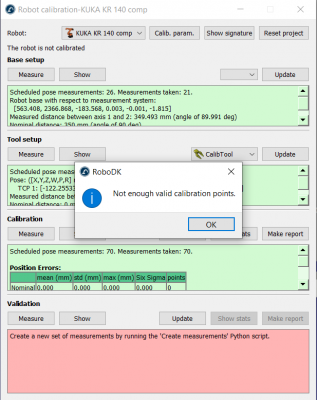I'm trying to calibrate a Kuka KR200-3 comp US arm. I've run through the calibration program several times and keep coming up with the error "Not enough valid calibration points." I tried with 60 and 70 points, same result:

I've attached my robodk project here, I'm using a KR140 comp because the KR200 is not in the library, but they have the same geometry:
pf0008_kr_1403_comp_en.pdf (kuka.com)
pf0009_kr_2003_comp_en.pdf (kuka.com)
Do I need to do 80 points? 100? I have a limited work space, maybe that affects things.
I have a KRC2 ed05 controller and can't get it to connect via ethernet so I'd rather not keep blindly doing tests, as each manual run takes me 2 hours.
Any ideas are appreciated, thanks!
I've attached my robodk project here, I'm using a KR140 comp because the KR200 is not in the library, but they have the same geometry:
pf0008_kr_1403_comp_en.pdf (kuka.com)
pf0009_kr_2003_comp_en.pdf (kuka.com)
Do I need to do 80 points? 100? I have a limited work space, maybe that affects things.
I have a KRC2 ed05 controller and can't get it to connect via ethernet so I'd rather not keep blindly doing tests, as each manual run takes me 2 hours.
Any ideas are appreciated, thanks!




